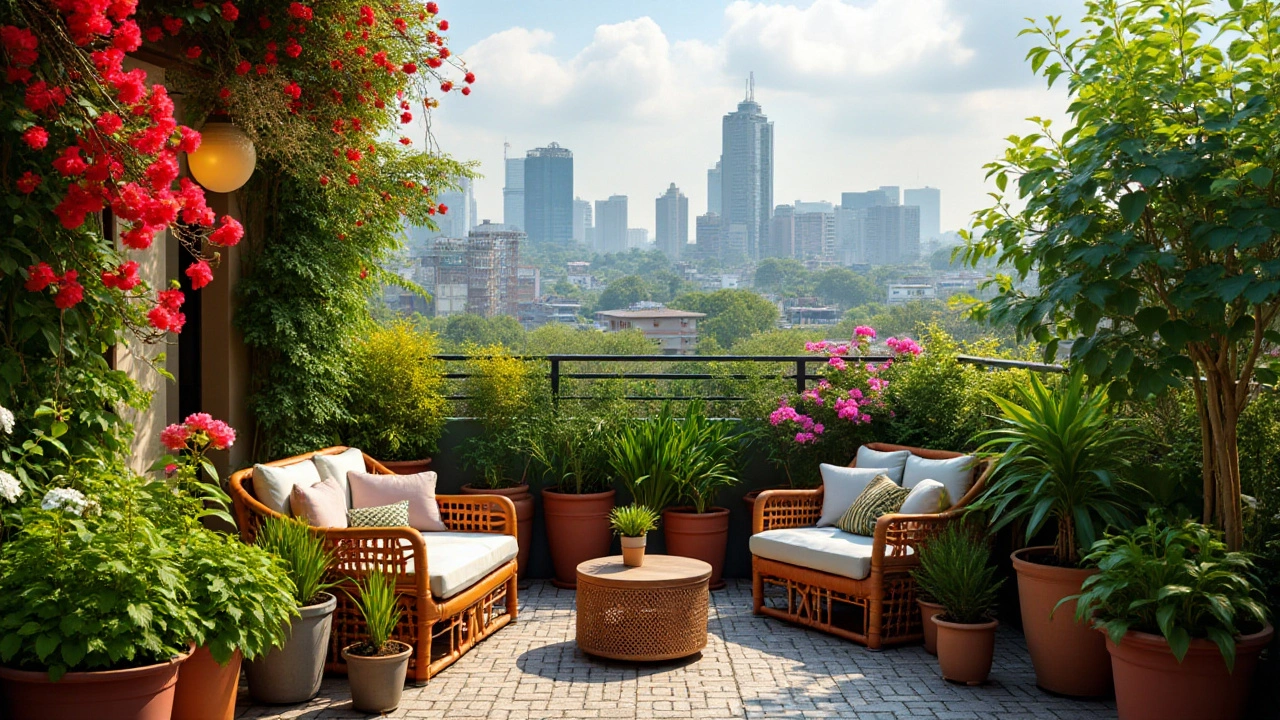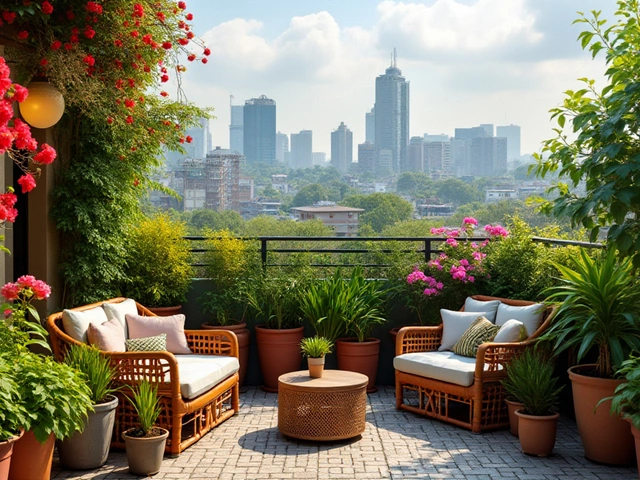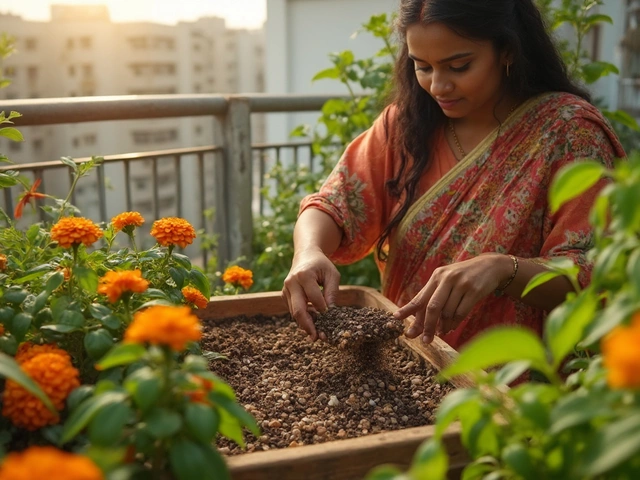Imagine stepping out onto your terrace, greeted by the fragrance of blooming flowers and the gentle rustle of leafy greens. A terrace garden is not just a patch of green; it's a personal oasis that adds charm and tranquility to your home. People often think that creating such a space is complicated, but with a little creativity and some practical steps, anyone can craft a beautiful terrace garden.
No matter the size of your space, thoughtful planning and design can help you maximize its potential. From selecting the right plants to arranging comfortable seating, this article will guide you through essential tips to make your terrace not only a feast for the eyes but also a functional outdoor retreat.
- Planning Your Space
- Choosing the Right Plants
- Designing with Style and Comfort
- Incorporating Sustainable Practices
- Maintaining Your Terrace Garden
Planning Your Space
Transforming a simple terrace into a thriving terrace garden begins with thoughtful planning. The first step is identifying what you want to achieve with your garden. Do you wish for a serene retreat for relaxation, a vibrant space for social gatherings, or perhaps a mix of both? This vision will guide the layout and elements you’ll need. Measure the dimensions of your terrace, noting areas with full sun, shade, or partial light. It’s critical to understand the microclimates because these affect your plant choices. Your sketch doesn't have to be perfect, but mapping out the space allows you to envision various arrangements, ensuring that everything fits seamlessly. Strategic layering and the use of vertical spaces can help maximize even limited areas with smart designs.
The world-renowned landscape designer, Piet Oudolf, once said, "A garden should make you feel you've entered a privileged space—a place not just set apart, but reverberant— and it should require nothing from you other than appreciation."
Different zones can be created to serve multiple purposes—a comfy seating area surrounded by lush plants, a place for a small herb garden, or decorative spaces for ornaments and garden art. Consider elements like wind and weather exposure, deciding whether you need protective structures like awnings or screens that shield from harsh conditions while adding a touch of style. Carefully placed lighting can enhance ambiance and usability of your terrace garden at night, showcasing features and creating mood lighting while ensuring safety. Position pathways or stepping stones to allow easy movement across the space, guiding visitors effortlessly through your garden's delights.
Maximizing the Potential of Your Space
In urban gardening, where space can be a premium, utilizing walls and railings for vertical gardens significantly increases your greenery without consuming precious floor area. Hang planters or use wall-mounted racks for creepers and small pots, turning your vertical surfaces into lush backdrops. A popular idea is to use trellises, allowing climbing plants like ivy or morning glory to naturally enhance privacy and create a living green wall. People often overlook the potential underfoot. Installing compact and charming water features or using textured materials like bamboo or colored tiles can turn floors into areas that engage the senses. Remember to ensure proper drainage in your terrace garden to avoid water accumulation which might damage plants or flooring.
| Feature | Purpose |
|---|---|
| Vertical Garden | Maximize greenery with limited space |
| Lighting | Enhance ambiance and safety |
| Pathways | Guide movement and structure flow |
Planning for water usage is essential, especially if you’re in a region with strict water regulations. Consider installing drip irrigation or rainwater collection systems to maintain your terrace garden efficiently. An irrigation system can save you precious time and water, ensuring each plant gets the right amount of moisture directly to its roots, promoting healthy and robust growth. Preparing these details in advance sets a clear blueprint on which your urban gardening escapade will flourish, making the dreaming and designing phase as enjoyable as the growth itself.
Choosing the Right Plants
When planning your terrace garden, the selection of plants is crucial to creating a vibrant yet harmonious outdoor space. To begin with, consider the climate and the amount of sunlight your terrace receives throughout the day. Plants like succulents and cacti, which are resilient to heat and require less water, thrive in sunny, arid conditions. On the other hand, ferns and hostas might be better suited for shaded areas and offer lush greenery. It's important to think about the size and growth pattern of the plants as well. For smaller spaces, vertical gardening can maximize your area effectively; plants like ivy and vines work wonders for this purpose, cascading down or spiraling upward beautifully.
Understanding your lifestyle and commitment level is key to maintaining your garden. If tending to plants regularly feels daunting, opt for low-maintenance varieties such as ZZ plants, snake plants, or pothos. They not only add aesthetic value but are also known for their air-purifying qualities. For a touch of color, consider flowering options like geraniums or marigolds, known for their longevity and low upkeep.
"Gardening is the work of a lifetime: you never finish." – Oscar de la RentaThis quote reminds us that while maintenance is ongoing, the choice of resilient plants eases the process significantly.
Besides aesthetics, you might also focus on sustainable practices, and choosing native plants is a smart and eco-friendly option. They are naturally adapted to the local climate, require less water and fewer chemicals, and provide a habitat for local wildlife. Herbs like basil, rosemary, or mint can also serve dual purposes, both as ornamental plants and useful additions to your kitchen. Consider the scent too; lavender and jasmine are not just visually appealing, they fill the air with delightful scents that enhance the overall experience. These choices illustrate the perfect blend of beauty and utility in terrace gardening.
Lastly, think about the type of containers you use. While terracotta pots might be classic, they can heat up or dry out quickly. Alternatives such as self-watering containers or using mulch over the soil can help retain moisture for a more sustainable garden. Remember, the key to thriving plants is understanding their needs, and matching those to what your urban gardening environment offers. By carefully selecting your plants, you can achieve a terrace that's both stunning and sustainable, providing joy and relaxation for years to come.
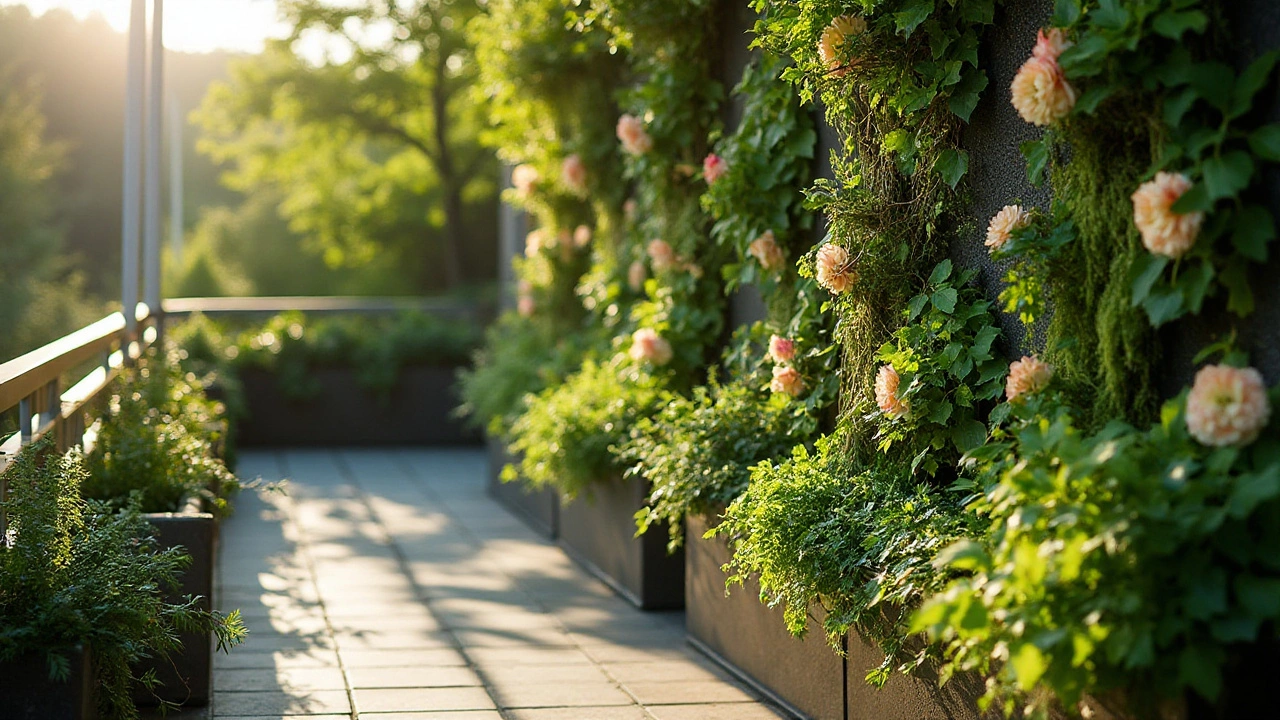
Designing with Style and Comfort
Creating a terrace that embodies both style and comfort involves thoughtful decisions about layout, furniture, and decor. The aim is to turn your terrace garden into a place where you can unwind with ease while being surrounded by the beauty and harmony of nature. The first step in achieving this is to consider the purpose of your terrace garden. Are you looking to host delightful evening gatherings, or perhaps you prefer a personal sanctuary for morning yoga sessions? Understanding how you intend to use the space will guide your design choices, helping you select pieces that balance aesthetics with functionality.
Seating is crucial when it comes to making your terrace both stylish and comfortable. Opt for durable, weather-resistant materials that can withstand the elements, such as teak, rattan, or metal, which also complements the natural vibes of a terrace garden. Adding cozy cushions or throws can not only enhance comfort but also introduce vibrant colors and patterns that reflect your personal style. Ultimately, the goal is to create a welcoming environment where you can relax with a book or sip your morning coffee, enveloped in the greenery of your urban gardening efforts.
Lighting plays a pivotal role in transforming your terrace into a stylish retreat during evening hours. Consider soft, ambient lighting that mimics the calm glow of moonlight, such as LED fairy lights or solar-powered lanterns. These not only accentuate the lushness of your garden but also create a tranquil ambiance. "Lighting can completely transform an outdoor space, bringing a touch of magic to even the simplest settings," says renowned landscape designer, Jane Doe. These subtle additions not only enhance the atmosphere but also allow you to enjoy your garden long after the sun has set.
Additionally, a small water feature, like a tabletop fountain, can introduce the soothing sounds of nature to your terrace, making it a multi-sensory experience. The sound of trickling water can mask urban noise, creating a serene oasis in the midst of a bustling city. Garden design is not a one-size-fits-all endeavor, and incorporating personal elements such as artwork or handpicked planters can add layers of character to your sanctuary. Remember, the charm of a terrace garden lies in its ability to reflect your personality and offer a space where luxury meets simplicity.
Finally, don’t forget the practical aspects of ensuring comfort, such as providing adequate shade for hotter days. Pergolas draped with climbing plants, or a large umbrella, can offer relief from the sun without compromising on style. With some thought and creativity, your outdoor decor decisions will not only beautify your terrace but also create a haven for relaxation and enjoyment, mirroring the calmness that a garden can bring into one's life.
Incorporating Sustainable Practices
Embracing sustainability in your terrace garden not only benefits the environment but also enhances the garden's appeal and longevity. A key approach is to select plants that are native to your locale. Native plants are typically more resilient to local pests and climate conditions, requiring less water and maintenance. This effectively minimizes the resources needed to support plant health and encourages biodiversity. When considering plants, think about the microclimates within your terrace—certain areas might be sunnier, others shaded. Create a mix that thrives in these varied conditions without demanding excessive water.
Another essential practice is water conservation. Implementing a rainwater collection system can be a game-changer. Simple solutions like placing containers to catch rainwater or more advanced setups with barrels can significantly reduce reliance on municipal water sources. Drip irrigation and self-watering pots can also be utilized to maintain soil moisture efficiently. These systems slowly release water directly to the plant roots, reducing waste and promoting optimal growth. For those passionate about sustainability, creating compost from kitchen scraps is a rewarding habit to enrich the soil naturally.
Integrating recycled materials into the terrace design further fosters environmentally friendly gardening. Reclaimed wood, recycled plastic, or planters made from leftover construction materials can create striking decor that is both stylish and sustainable. Decor ideas like these not only save items from ending up in landfills but also give your terrace a unique charm. If you need more inspiration, focusing on quality over quantity is key. Choose durable furniture and decor items that will last and avoid needing frequent replacements.
As Rachel Carson once said, "In nature, nothing exists alone." This mindset encourages a holistic view where all elements of your terrace garden are interconnected. By incorporating natural habitats like birdhouses or insect hotels, you invite beneficial wildlife that contributes to the ecosystem.
On the subject of energy efficiency, lighting plays a vital role. Opt for solar-powered lights to illuminate your space. Not only do they reduce electricity usage, but they also require minimal maintenance. Position these thoughtfully to highlight paths, seating areas, or particular plant features. If you plan to use certain appliances on your terrace, such as heaters during colder months, select energy-efficient models to lessen the environmental impact.
To encourage sustainable practices on your terrace, consider involving your community or neighborhood. Host seed exchanges or plant swaps to share resources and experiences. This not only builds a sense of community but also spreads sustainable practices beyond your terrace, making a larger impact. You may also join local urban gardening groups to learn from others' innovations and successes. With these ideas in mind, incorporating sustainable practices into your terrace garden becomes a fulfilling endeavor that benefits not only your immediate surroundings but also contributes to global efforts in environmental conservation.
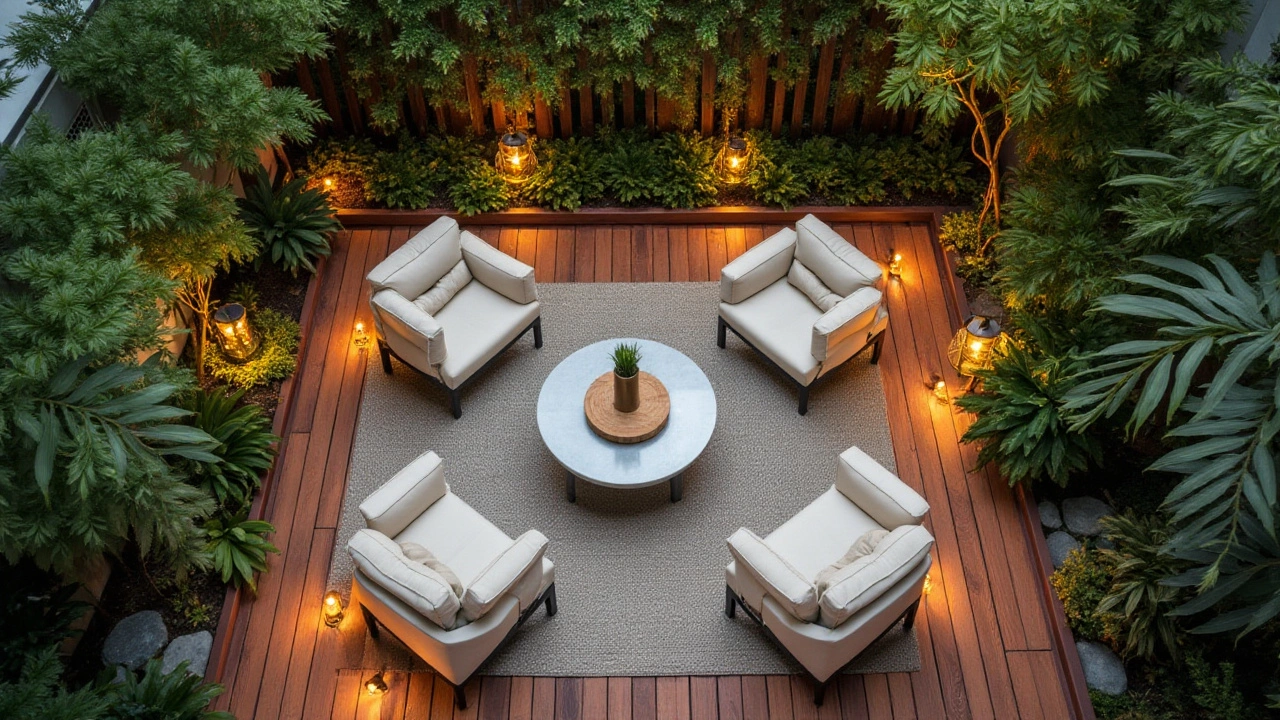
Maintaining Your Terrace Garden
Keeping a terrace garden healthy and vibrant is a rewarding endeavor that requires consistent attention and care. Regular maintenance ensures that your terrace remains a beautiful refuge throughout the seasons. One fundamental aspect of maintenance is watering. The frequency and amount depend on the plant species and the climate of your area. In hotter months, your plants may necessitate daily watering, while during cooler periods, a few times a week could be sufficient. It’s crucial to monitor the soil moisture to avoid overwatering, which can lead to root rot, a common issue in container gardening.
Pruning is another critical task in maintaining your terrace garden. It helps manage plant size, encourages healthy growth, and promotes flowering. Deadheading flowers, which involves removing spent blooms, not only keeps your plants looking tidy but also encourages new blooms to develop. Consider allocating time every few weeks to assess your plants and trim them as needed. Fertilization is equally important. A general rule is to feed your terrace plants with a balanced liquid fertilizer every four to six weeks during the growing season. This provides necessary nutrients to sustain their growth. In the off-season, a slow-release granular fertilizer could be used.
Pest management is also a vital component of terrace garden maintenance. Common terrace plants may attract aphids, spider mites, or whiteflies. A gentle way to tackle these pests is with neem oil or insecticidal soap, which is easier on the environment and safe for your plants. It's beneficial to inspect your garden regularly for the first signs of infestation so that you can intervene before the pests multiply. Remember, a sustainable garden thrives on biodiversity, so encourage beneficial insects to take care of their pest counterparts.
"The glory of gardening: hands in the dirt, head in the sun, heart with nature. To nurture a garden is to feed not just the body, but the soul," – Alfred Austin, a famous English poet who spoke about the profound impact of gardening on our spirits.
Presents an insightful look at how gardening enriches our lives. Austin's sentiment underscores the emotional benefits of gardening, which often mirror the rewards of attentive terrace maintenance.
Additionally, address practical considerations like checking the health of the pots and containers. Stay vigilant about any leakage or cracks, as these could affect plant growth. Ensure that your containers have adequate drainage to prevent water pooling, which could lead to the dreaded root rot. Plant rotation is another strategy to explore. By rotating your plants occasionally, you can ensure that all receive adequate sunlight and ventilation, which minimizes the risk of diseases taking hold. Finally, make a habit of sweeping and cleaning your terrace space regularly to keep it an inviting and attractive part of your home. With each meticulous task, you nurture not only your garden but also the bond between you and your living green space.
